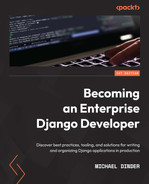Table of Contents
Preface
Who this book is for
What this book covers
To get the most out of this book
Download the example code files
Code in Action
Download the color images
Conventions used
Get in touch
Share Your Thoughts
Part 1 – Starting a Project
Chapter 1: Undertaking a Colossal Project
Technical requirements
Building an enterprise
Reasons to choose enterprise-level applications
Types of enterprise systems
Why Python/Django?
Types of APIs
Designing and planning
Requirements gathering
Visualization and interpretation
Hosting and deployment
Creating and configuring a Heroku plan
Configuring Heroku environments
Custom repositories
Advanced deployment
Domain Name System
Summary
Chapter 2: Project Configuration
Technical requirements
Choosing development tools
Text editors
Integrated development environments
Starting a project
Using the IDE
Using the command line
Creating a virtual environment
Configuring the requirements.txt file(s)
Using the IDE
Using the command line
Project configuration
Django settings.py file
Creating an environment file
Creating a Procfile
Django static files
Django media files
Creating a .gitignore file
Creating a Django app
Using basic database settings
SQLite
MySQL
MariaDB
Oracle
SQL Server
PostgreSQL
Preparing PostgreSQL for Heroku
Installing PostgreSQL
Using the PgAdmin tool
Environment connection settings
Building initial table structures
Remote data migrations
Heroku database push/pull operations
Summary
Chapter 3: Models, Relations, and Inheritance
Technical requirements
Preparing for this chapter
Writing model classes
Standard field types
Third-party field types
Model field validators
Working with model field relationships
Field arguments
Field type – ForeignKey
Field type – ManyToManyField
Mutable versus immutable objects
Using the Meta subclass
Meta options – verbose_name and verbose_name_plural
Meta option – ordering
Meta option – indexes
Meta option – db_table
Customizing models
Writing methods
Decorators
Extending models
Extending basic model classes
Extending the Django User model
Using the Django shell
Running basic Python scripts
Generating a SECRET_KEY variable
Saving data
Loading the chapter_3 data fixture
Performing queries
Model method – all()
Model method – get()
Model method – filter()
Aggregates
Writing model managers
Summary
Part 2 – Django Components
Chapter 4: URLs, Views, and Templates
Technical requirements
Preparing for this chapter
Configuring URL patterns
Basic path functions
Redirecting patterns
Using path converters
Mapping URL patterns
Using simple views
Using kwargs in views
Working with conditional responses
Linking models to views and templates
Resolving URLs
Naming URL patterns
Using the reverse() function
Using the {% url %} template tag
Processing trailing slashes
Resolving absolute URLs
Creating a context processor
From the request object
From within a model class
Working with complex views
Class-based views
Extending class-based views
Asynchronous views
Working with templates
Template tags
Template filters
Custom tags and filters
Error page templates
Summary
Chapter 5: Django Forms
Technical requirements
Preparing for this chapter
Types of forms
Form class – Form
Form class – ModelForm
Using form fields
Common field arguments
Field widgets
Field validators
Cleaning forms
Method – clean_{{ your_field_name }}()
Method – clean()
Creating custom form fields
Field class – Field
Using a custom field
Working with form views
View class – FormView
HTTP request methods
Rendering forms in templates
Render form – as_p
Render form – as_table
Render form – as_ul
Render form – using template_name
Render demo
Linking a model to a form
View class – CreateView
View class – UpdateView
Adding inline formsets
Formset function – formset_factory
Using inline formsets in the view class
Rendering inline formsets in the template
Dynamic inline formsets
Summary
Chapter 6: Exploring the Django Admin Site
Technical requirements
Preparing for this chapter
Using the Django admin site
Activating the Django admin site
Logging into the Django admin site
Writing admin classes
Registering models
Configuring admin class options
Changelist view-related options
Change/add view-related options
Add view-related options
Adding admin class methods
Method – get_form()
Method – save_model()
Method – delete_model()
Writing custom admin form classes
Initializing an admin form
Using the Django authentication system
Adding a seller
Granting permissions
Permission groups
Summary
Chapter 7: Working with Messages, Email Notifications, and PDF Reports
Technical requirements
Preparing for this chapter
Creating a Mailtrap account
Using the Django messages framework
Enabling the Django messages framework
Creating a message
Displaying messages
Configuring email notifications
As plain text emails
As HTML emails
As HTML emails with a plain text alternative
With file attachments
That fail silently
Writing custom email templates
For plain text emails
For HTML emails
Providing template context
Generating PDF reports
As template-based PDFs
Adding context
Summary
Part 3 – Advanced Django Components
Chapter 8: Working with the Django REST Framework
Technical requirements
Preparing for this chapter
Installing the Django REST framework
Serializing objects
The serializer classes
The viewset classes
Using URL routers
Using the Browsable API
Building SPA-like pages
Creating the view
Building the template
Writing the JavaScript
Mapping the URL pattern
First demo
Writing custom API endpoints
Creating the view
Building the template
Modifying the JavaScript
Mapping the URL pattern
Second demo
Authenticating with tokens
Project configuration
Creating the view
Building the template
Modifying the JavaScript
Mapping the URL pattern
Third demo
Summary
Chapter 9: Django Testing
Technical requirements
Preparing for this chapter
Understanding automated testing in Django
Getting started with unit testing
Basic unit test script
Testing Django models
Testing HTTP view requests
Testing method-based views
Testing class-based views
Testing authenticated view requests
Using the Client() class
Testing Django REST API endpoints
Creating an object test case
Updating an object test case
Using the DjDT
Installing the DjDT
How to use the DjDT
Summary
Chapter 10: Database Management
Technical requirements
Preparing for this chapter
Exporting data into a data fixture
Using the dumpdata command
Importing data from a data fixture
Using the importdata command
Using the select_related() method
Creating the view
Building the template
Mapping the URL pattern
First demo
Using the prefetch_related() method
Vehicles view
Sellers view
Using the Prefetch() class
Modifying the view
Modifying the template
Fourth demo
Summary
Why subscribe?
Other Books You May Enjoy
Share Your Thoughts
..................Content has been hidden....................
You can't read the all page of ebook, please click here login for view all page.
